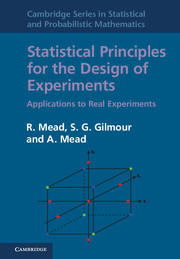Book contents
7 - Blocking and control
from Part II - First subject
Published online by Cambridge University Press: 05 November 2012
Summary
Preliminary examples
(a) An experiment is to be designed to investigate the effects of supplementary heating, supplementary lighting and carbon dioxide on the growth of peppers in glasshouses. The number of possible treatment combinations is eight, comprising all combinations of two levels of heating (standard or supplementary), two levels of lighting (standard or supplementary) and two levels of CO2 (background or added). Each observation on a treatment combination requires a separate glasshouse compartment and there are 12 glasshouse compartments available, arranged in two linear runs of six compartments (each running east–west, one with a northerly aspect, the other with a southerly aspect). Compartments in different runs are therefore likely to produce rather different yields. The problem is to design an experiment in two blocks each of six units to compare the eight factorial treatment combinations. It is intended to have a second experiment, using the same glasshouse compartments, in the next year, after which the most effective treatment combination will be recommended for use.
(b) In a screening study 14 fungal isolates of a potential biological control agent of onion white rot (Sclerotiorum cepivorum) are to be produced using three standard methods and tested by assessing germination of sclerotia in the laboratory. The aim of the study is to compare the 42 treatment combinations and select the best six for more detailed research. The available resources allow the production of three replicate batches of each treatment combination, but at most 18 batches can be processed in a single production run, and it is known that there are likely to be substantial differences between production runs (each takes several weeks).
- Type
- Chapter
- Information
- Statistical Principles for the Design of ExperimentsApplications to Real Experiments, pp. 142 - 181Publisher: Cambridge University PressPrint publication year: 2012

